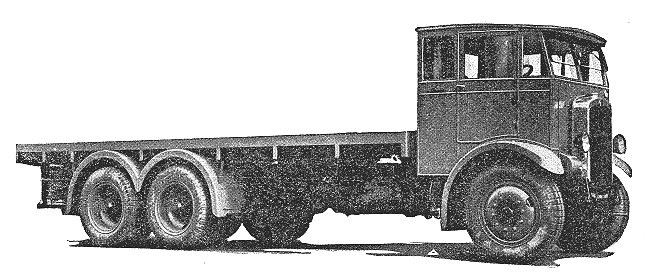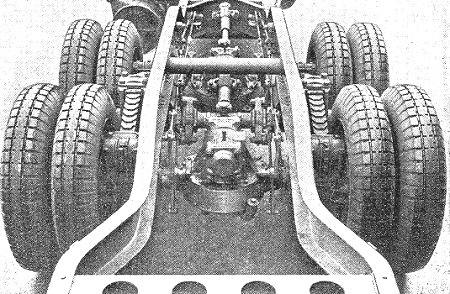| Oil-Engined Models In the
Guy Range Some of the
outstanding features of an interesting range of medium-sized and
large-capacity vehicles
The article is from The
Commercial Motor, October 27th, 1931 |
|
During the past decade Guy Motors, Ltd., of
Wolverhampton, has gained world renown for large-capacity
vehicles of both the freight and passenger types. Many
six-wheeled machines have been supplied to various Governments
and there are a number of bogie-axled buses operating in Great
Britain, besides fleets of goods vehicles of all sizes, ranging
from 30 cwt. capacity to 11 tons. The programme for a new season
of such a concern is, therefore, regarded with interest.
Of outstanding importance to large
operators is the fact that various chassis, at present being
manufactured by the Guy Company, can now be obtained with
compression-ignition engines in place of the usual petrol type.
These particular models are the Goliath 11 tonner, the Warrior 6
tonner, and the Conquest and Invincible 32 seater and 51seater
passenger chassis.
In each case the power units are
interchangeable (i.e. oil or petrol types) and it is possible
for an existing petrol engined chassis to be equipped with a
compression-ignition engine without involving a great deal of
alteration to such items as controls, and without making any
structural modification to the general build of the chassis. |

The Guy 11 ton six-wheeled lorry equipped with a
heavy-oil engine.
|
Before describing the oil engine, which is
the new type Gardner six-cylindered unit, we will enumerate a
few of the salient points in the design of the 1932 chassis.
Several alterations have been made in the
latest type. To start with the four models already mentioned,
the 6 tonner and 11 tonner, and the 32 seater and 51 seater
passenger vehicles have new front axles which incorporate
directly operating Dewandre vacuum cylinders attached to the
brake drum and shoe assembly. The use of such a system has
entailed redesigning the brake rods generally and we are assured
that the new layout provides a fine, well-balanced retarding
action.
A normal Dewandre servo motor is attached
to the off side of the frame and is coupled in the ordinary way
to the pedal; a rod runs rearwards to the rear brake
cross-shaft, whilst two pipes lead from the master valve of the
main servo to the auxiliary cylinders attached to the front-axle
assembly.
The frame of the 11 tonner is slightly
shorter than in previous models but it retains its exceedingly
strong section of 12 in. depth with flanges made from seven
sixteenths of an inch steel. The cross bracings are deep and
although extremely strong, are of relatively small weight. The
tyre size is 40 in. by 8 in., with twins at the rear.
Another point of interest concerns the
engine, clutch, and gearbox mounting, which, as in previous
models is effected by means of a sub-frame, this last named
component if rigidly mounted in the frame, compensates for
relative movement if the vehicle is used over uneven ground. The
gearbox has been moved further back than in the 1931 types and
fabric joints have been incorporated in the clutch shaft;
furthermore, the box itself is three-point mounted to the
sub-frame.
A new pattern of radiator is used
throughout the larger machine, the outstanding feature being a
stone guard which protects the more delicate parts from damage.
In the petrol engined version, power units have been improved by
redesigning the cooling system. The water pump has been slowed
down somewhat and the water spaces in the cylinder heads altered
to allow a better flow of water around the exhaust pockets. |
 |
A near-side view of the new Gardner
six-cylindered oil engine used in certain Guy models, showing
fuel pump and the controls which permit starting by hand. |
| We can now deal with the Gardner power unit. The model
chosen for use in the Guy vehicles is the six-cylindered model
which, at 1,650 r.p.m. gives a maximum b.h.p. of rather more
than 100. As is usual in compression-ignition engines, an
exceedingly good torque figure is attained at low and medium
crankshaft speeds; actually this Gardner unit develops
approximately 350 lb.-ft. at 1,000 r.p.m., thereby giving the
vehicle a most creditable top gear performance. |

The front axle assembly of the Guy 11
tonner showing flexible connections to the Dewandre vacuum servo
cylinders operating the brakes. |
|
It will be recalled that the latest engine
of this make has received careful attention at the hands of the
designers in regard to the vexed question of weight. The unit,
with the flywheel, oil and water, scales 1,480 lb. Electrical
apparatus is not included in this weight, because it is
considered to be a non-essential part of the general equipment,
although a comprehensive layout has been included in the Guy
oil-engined vehicles.
With bore and stroke dimensions of 4¼ ins.
and 6 ins. respectively, the R.A.C. rating works out at 43.5
hp., which is a usual figure for six-cylindered petrol units as
fitted to the large chassis produced by the Guy concern. The
compression ratio is 13 to 1, the fuel-injection pressure at
maximum being in the order of 2,000 lb. per sq. in.
A gear-type oil pump forces lubricant to
all the working parts, with a special filtering device
incorporated in the system to ensure freedom from trouble over
long periods of operation. |
| A view from the rear of
the bogie of the 11 ton six-wheeler showing chief constructional
features, including double inverted semi-elliptic springs. |
 |
|
In this latest Gardner engine, many
improvements over the earlier types have been incorporated. For
instance, modifications have been made to the valve diameters
and the timing, port and passage contours, etc., whilst the
special design of inlet valve with tangential location to ensure
good turbulence is symmetrical with the exhaust valves.
Injection is, of course, direct, and the
differential injectors which are centrally located in the
combustion spaces are of exactly the same type as are used in
all kinds of Gardner engine.
Due to the excellent torque figure at
medium speeds, the axle ratios of the chassis having the
compression-ignition engines have been raised somewhat; the
ratios are now 8.25 to 1. |
 |
Return to the
previous page |
|